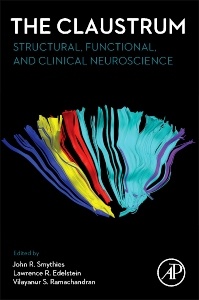Description
The Claustrum
Structural, Functional, and Clinical Neuroscience
Coordinators: Smythies John R., Edelstein Lawrence, Ramachandran Vilayanur S.
Language: English
Subject for The Claustrum:
408 p. · 15x22.8 cm · Hardback
Description
/li>Contents
/li>Readership
/li>Biography
/li>Comment
/li>
The present day is witnessing an explosion of our understanding of how the brain works at all levels, in which complexity is piled on complexity, and mechanisms of astonishing elegance are being continually discovered. This process is most developed in the major areas of the brain, such as the cortex, thalamus, and striatum. The Claustrum instead focuses on a small, remote, and, until recently, relatively unknown area of the brain. In recent years, researchers have come to believe that the claustrum is concerned with consciousness, a bold hypothesis supported by the claustrum?s two-way connections with nearly every other region of the brain and its seeming involvement with multisensory integrations?the hallmark of consciousness. The claustrum, previously in a humble position at the back of the stage, might in fact be the conductor of the brain?s orchestra.
The Claustrum brings together leading experts on the claustrum from the varied disciplines of neuroscience, providing a state-of-the-art presentation of what is currently known about the claustrum, promising lines of current research (including epigenetics), and projections of new lines of investigation on the horizon.
Basic Research 1. History of the Study and Nomenclature of the Claustrum 2. The Structure and Connections of the Claustrum 3. The Neurochemistry of the Claustrum 4. The Development and Evolution of the Claustrum 5. The Physiology of the Claustrum 6. Neurocomputation and Coding in the Claustrum: Comparisons with the Pulvinar 7. High-Definition Fiber Tractography of the Human Claustrum
Clinical Research 8. The Delayed Development of the Claustrum in Autism 9. The Claustrum and Schizophrenia 10. The Claustrum and Epilepsy 11. The Claustrum and Alzheimer's Disease 12. The Claustrum and Parkinson’s Disease
Hypotheses and Next Steps 13. Hypotheses Relating to the Function of the Claustrum 14. What Is it to Be Conscious? 15. Selected Areas for Future Research on the Claustrum
Researchers and advanced students in neuroscience, neurology, neuropsychiatry, and neuropsychology
Spring semester 1974, State University of New York at Stony Brook, “Introduction to Physiological Psychology, Professor John Stamm (mentor and frontal lobe physiologist par excellence). “Essentials of Physiological Psychology, by Sebastian P. Grossman. As a significant percentage of our final grade, we were tasked with submitting a term paper on the brain structure of our choosing, to be selected from those mentioned in our
- Develops a unifying hypothesis about the claustrum’s role in consciousness, as well as the integration of sensory information and other higher brain functions
- Discusses the involvement of the claustrum with autism, schizophrenia, epilepsy, Alzheimer’s disease, and Parkinson’s disease
- Coverage of all aspects of the claustrum, from its evolution and development to promising new lines of research, including epigenetics, provides a platform and point of reference for future investigative efforts
These books may interest you

The Brain and its Functions 129.87 €



